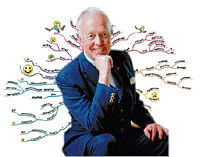Learn the way a baby learns

How do you get children to enthusiastically sit down with their homework and study from their notes? Exasperated parents will tell you that’s a task that’s next to impossible.
Inventor of the Mind Map, Tony Buzan, however, will have you think otherwise. Speaking exclusively to Deccan Herald while in Bangalore for a seminar on ‘Creativity and Innovation using Mind Maps’, he emphasised that all children without exception are born geniuses and learn naturally. “Learning a language is more difficult than learning to play the piano, yet every child (unless he or she has a congenital problem) accomplishes this task remarkably well, without too much adult intervention.”
A baby learns its mother tongue, not from books but by imitating those around it, by making mistakes on the way, by experimenting with pronunciation and accents. Babies observe the world around them and make associations and links. They use all their senses to record their idea of the world. A toddler will know by looking at its mother if she’s angry or happy, which is a very intelligent thing to do, when you realise nobody has taught him to read expressions, says Buzan.
Yet, when we send this same child to school, we force him to sit still, chide him for making mistakes and for daring to think differently, we make him read from textbooks, and write notes, make him memorise boring facts, and then expect him to like his studies. This is torture when you realise that our brains are hardwired to take in multi-sensory stimuli to understand, learn and retain that learning. Rather than words or letters, it is images that stay in our memory. For example, when we hear the word ‘apple’, we get an image of it in our heads. It is not the word APPLE that comes to our mind, points out Buzan.
Moreover, we continue to believe that learning happens only when it is verbalised. While verbalising our thoughts is important, it is not the only way of thinking, says Tony Buzan.
“When a toddler wants water, he or she will most probably point to water and say, ‘Mama, wa...wa’. Have you ever heard a toddler say, ‘Mother, would you be so nice as to get me a glass of water from the kitchen to quench my thirst,’” asks Buzan.
Additionally, our brain does not think linearly, as we are erroneously taught to think in school, but in a radiant manner, with thoughts radiating outwards from a central image, says Buzan.
Buzan did a lot of research to understand the way the brain functions, prompted by an incident at his school. When he was about seven his class was given a nature test in which he scored very highly, while his friend who was much more knowledgeable on the subject scored poorly. He knew then that there was something wrong about the way the students were assessed. Later, when he was in college he realised that his copious notes did nothing to help him remember much of what he had studied.
It was only after studying the ancient memory systems of the Indians, Greeks, and Arabs and the note-making techniques of Leonard da Vinci, Einstein, Picasso, Beethoven, and other greats that he began to understand why. It hit him that he couldn’t remember his notes because they were in monochrome and linear, and therefore boring. Likewise, although we are taught to be logical, verbal and mathematical, it was our vibrant imagination that played a major role in fixing information in our memory. This realisation led him to invent the Mind Map which makes use of images and colour, links and association.
If you want to remember your notes, use a lot of images, pictures, colours, codes and symbols, says Buzan. When you’re making notes have an image for your topic in the centre of your page. Then let any ideas you may have about the topic radiate from the central image. Connect all the ideas using coloured lines or arrows. Use only key words and not entire sentences when you make notes. Underline or use any other sort of emphasis to highlight the key words. Interlink ideas with associations that come up in your mind.
So, can you get children to sit down with their notes. Yes, if you are willing to shift your focus from traditional notes to a radically different form. Encourage your child to use a lot of colour when he’s making notes and let him draw images that come to his mind. Let him begin his notes from the centre of the page. His notes may look illegible and messy, but the associations they bring up will be intelligible to him and help him remember better.
Deccan Herald is on WhatsApp Channels| Join now for Breaking News & Editor's Picks